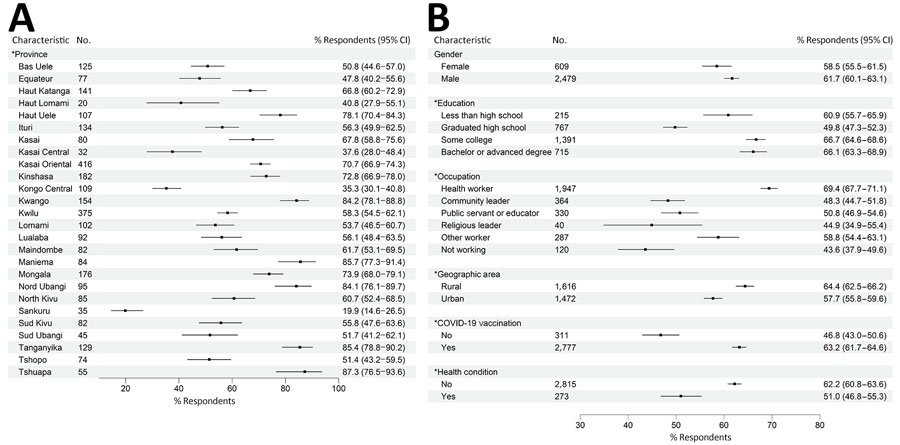Mpox Vaccine Acceptance, Democratic Republic of the Congo
Skylar Petrichko
1, Jason Kindrachuk
1, Dalau Nkamba, Megan Halbrook, Sydney Merritt, Handdy Kalengi, Leonard Kamba, Michael Beya, Nicole A. Hoff, Christophe Luhata, Didine K. Kaba
2, and Anne W. Rimoin
2
Author affiliation: Jonathan and Karin Fielding School of Public Health, University of California, Los Angeles, California, USA (S. Petrichko, M. Halbrook, S. Merritt, N.A. Hoff, A.W. Rimoin); Max Rady College of Medicine, University of Manitoba, Winnipeg, Manitoba, Canada (J. Kindrachuk); Kinshasa School of Public Health, University of Kinshasa, Kinshasa, Democratic Republic of the Congo (D. Nkamba, H. Kalengi, L. Kamba, M. Beya, D.K. Kaba); Ministry of Health, Kinshasa (C. Luhata)
Main Article
Figure 3

Figure 3. Percentage of mpox vaccine acceptance and demographic characteristic perceptions from a telephone phone survey about mpox vaccine acceptance conducted during December 2023–February 2024, by province, the Democratic Republic of the Congo. Responses were stratified by sociodemographic characteristics and known mpox risk factors; COVID-19 vaccination was dichotomized by whether the respondent received the COVID-19 vaccine. Health conditions were dichotomized on the basis of whether the respondent stated they had a chronic disease or were immunocompromised. Asterisks (*) indicate p<0.05 by χ2 test. Error bars indicate 95% CIs.
Main Article
Page created: October 15, 2024
Page updated: November 26, 2024
Page reviewed: November 26, 2024
The conclusions, findings, and opinions expressed by authors contributing to this journal do not necessarily reflect the official position of the U.S. Department of Health and Human Services, the Public Health Service, the Centers for Disease Control and Prevention, or the authors' affiliated institutions. Use of trade names is for identification only and does not imply endorsement by any of the groups named above.
